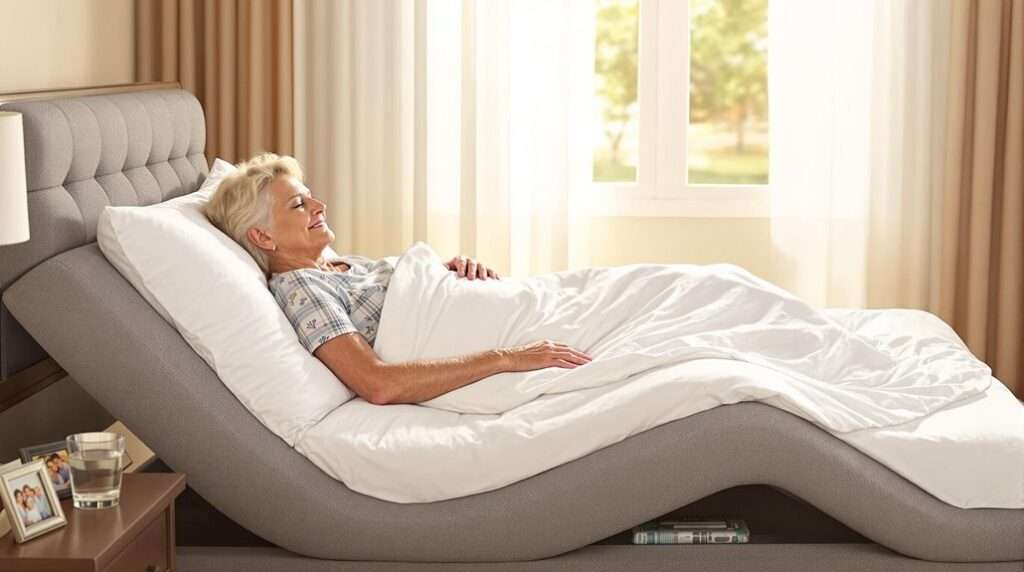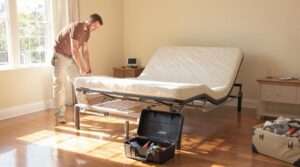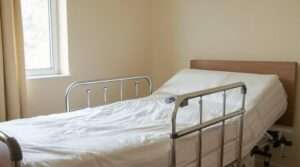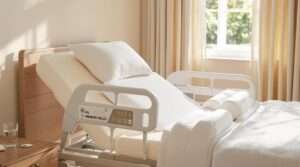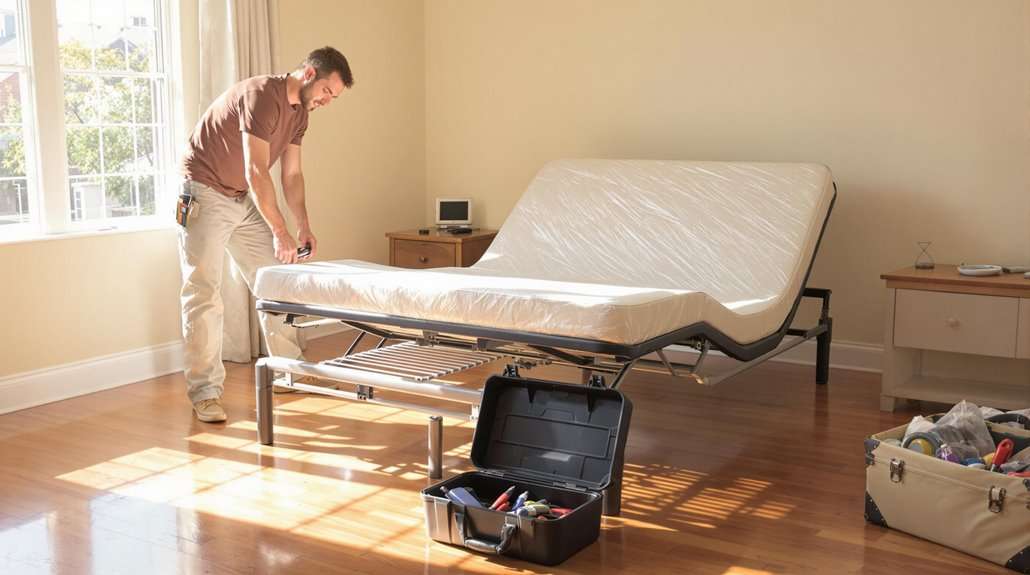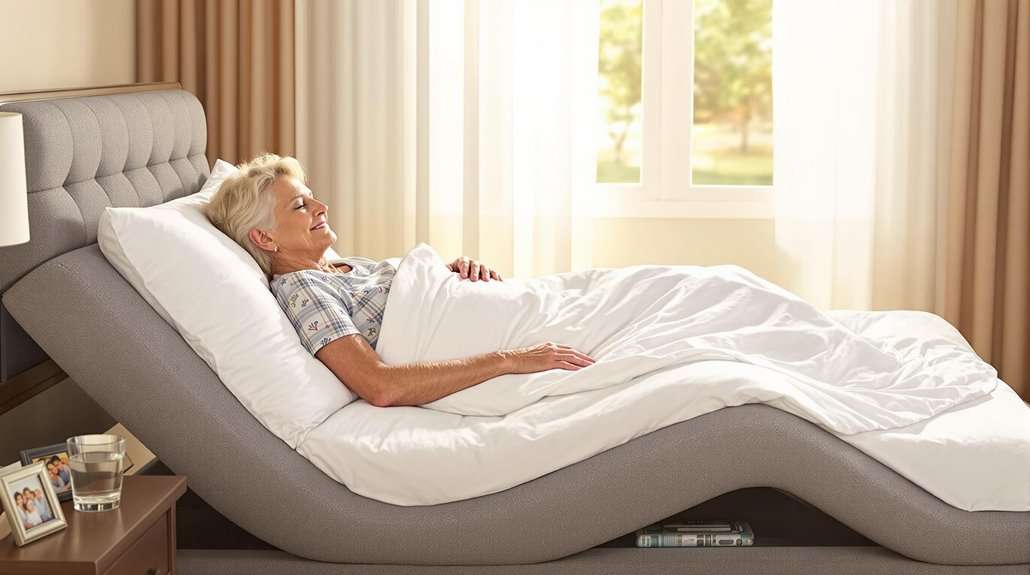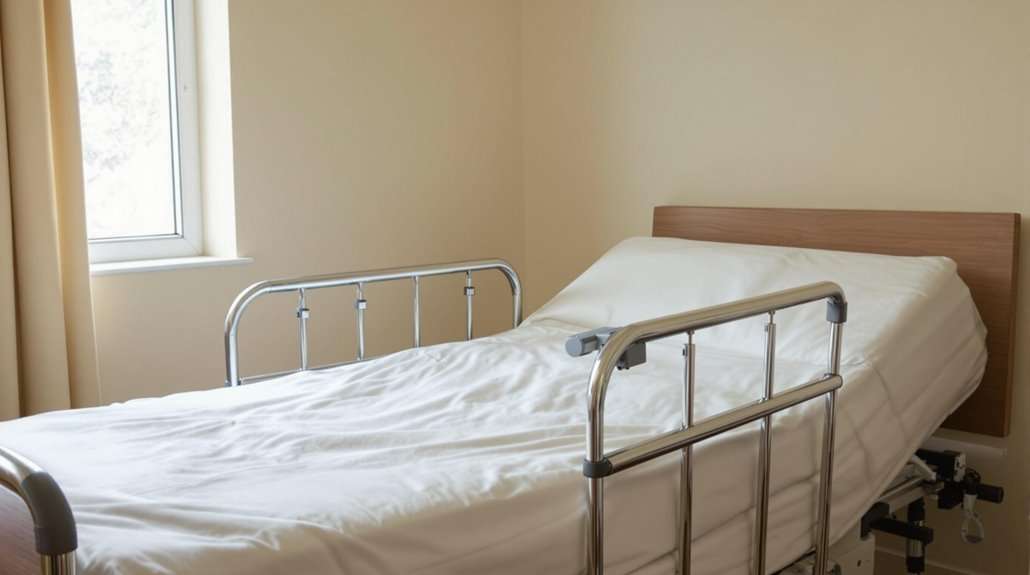Adjustable beds enhance therapeutic support for elderly individuals through precision biomechanical positioning and advanced safety features. Quality models incorporate programmable memory positions, height adjustability (12-24 inches), and weight capacities ranging from 650-850 pounds. Essential features include under-bed illumination, non-slip mattress supports, and remote-controlled functionality for enhanced mobility. Top-rated options like the Nectar Premier and Tempur-Pedic Ergo Power Base deliver superior lumbar support and massage capabilities. Clinical studies indicate 85-90% of users report improved sleep quality, while 62% experience reduced joint pain. Understanding the full spectrum of features guarantees ideal selection for individual therapeutic needs.
📋✅
- Nectar Premier Adjustable Bed Frame offers five preset positions and under-bed lighting, making nighttime mobility safer for seniors.
- Quality adjustable beds support 600-1,000 pounds and cost between $1,000-$1,500 for Queen size bases.
- Height adjustability from 12-24 inches, reinforced side rails, and non-slip mattress supports maximize safety during bed transfers.
- Features like USB ports, programmable memory positions, and voice commands enhance convenience and accessibility for elderly users.
- Therapeutic benefits include customizable weight distribution and massage functions, with 85-90% of users reporting improved sleep quality.
Understanding Adjustable Beds

Adjustable bed systems represent a sophisticated advancement in adaptive sleep technology, incorporating mechanized components that allow for precise positional modifications of both head and foot sections. This adjustable technology facilitates ideal body alignment while integrating auxiliary features such as massage functions and programmable memory positions for consistent sleep enhancement. With weight capacities ranging from 650 to 850 pounds, these beds provide robust support for various body types.
The functional design encompasses both therapeutic and practical elements, including integrated USB ports for device connectivity and strategic under-bed illumination for nocturnal navigation. These systems commonly incorporate specialized mattress compatibility, particularly with natural latex surfaces, to maximize pressure distribution and support integrity. One-touch controls enable caregivers to make quick adjustments while providing care.
Safety mechanisms are methodically integrated into the design architecture, featuring protective side rails that serve dual functions: fall prevention and mobility assistance. The operational interface prioritizes user accessibility through simplified control mechanisms, while maintaining sophisticated functionality. The zero-gravity positioning capability demonstrates the biomechanical emphasis of these systems, strategically distributing body weight to minimize pressure points and improve circulatory function.
These adaptive sleep systems are engineered to address specific health conditions, including respiratory complications, post-surgical recovery requirements, and chronic pain management, while maintaining focus on overall sleep quality enhancement through customizable positioning options.
Top Benefits for Seniors
Building upon the technological framework of adjustable bed systems, the vast benefits for senior users manifest across multiple physiological and functional domains. These adjustable bed benefits specifically address critical aspects of senior comfort through biomechanical optimization and therapeutic positioning capabilities. The easy-to-use controllers enable seniors to make quick adjustments without assistance.
The primary therapeutic advantages include pain management through customizable weight distribution, zero-gravity positioning for joint pressure reduction, and integrated massage functionality for muscular relief. Sleep quality enhancement is achieved through position-specific interventions, particularly in addressing sleep disorders and acid reflux through strategic head elevation and circulatory optimization. With features supporting up to 750 pounds weight capacity, these systems accommodate users of various sizes safely and securely.
Mobility enhancement and independence preservation are facilitated through safety-oriented features, including under-bed illumination, remote-controlled adjustments, and wall-glide technology for maintaining nightstand accessibility. The incorporation of adjustable height mechanisms guarantees safe bed entry and exit protocols.
From a holistic health perspective, these systems address specific conditions such as restless leg syndrome while promoting thorough sleep hygiene through programmable positions and memory presets. The cumulative effect of these features creates a therapeutic environment that systematically addresses age-related challenges while maintaining autonomy and enhancing overall quality of life for senior users.
Essential Safety Features
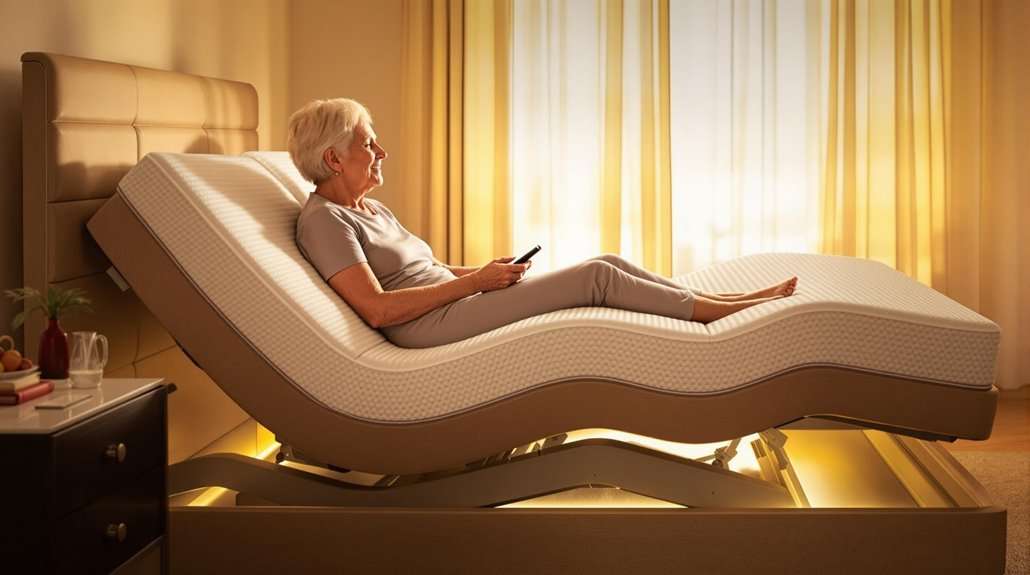
The ideal height adjustment capability of adjustable beds, ranging from 12 to 24 inches, provides essential biomechanical support for safe ingress and egress among elderly users. A stable bed height configuration, enhanced by non-slip mattress support bars and secure leg placement, greatly reduces the risk of destabilization during transfers. Reinforced side rails offer an additional layer of protection during sleep and movement. Strategic under-bed illumination combined with integrated bed exit alarm systems creates an all-encompassing nocturnal safety protocol, effectively minimizing fall incidents during nighttime ambulation. The incorporation of dual massage functions can further enhance stability by promoting better circulation and muscle relaxation during rest periods.
Bed Height Stability
Maintaining ideal bed height stability constitutes a fundamental safety requirement for elderly care environments, where precise mechanical adjustments and weight distribution mechanisms work in concert to prevent accidents. The engineering specifications demand weight capacities exceeding 250kg, incorporating robust support systems and strategically positioned bed legs to eliminate stability concerns during height adjustments. Modern beds feature wall-hugging technology that keeps users within easy reach of nightstands and personal items even during height adjustments. Zero gravity positions enhance comfort while maintaining essential stability during adjustments.
Critical stability features include reinforced mattress support bars that prevent lateral movement and specialized weight distribution mechanisms that maintain equilibrium across all height settings. The integration of smooth electronic controls facilitates precise shifts between positions, while high-low functionality accommodates both Trendelenburg and Reverse Trendelenburg positioning without compromising structural integrity.
Safety certification standards mandate consistent stability verification across the operational height range of 12 to 24 inches. The implementation of controlled lowering mechanisms prevents sudden drops, while the strategic placement of support structures guarantees uniform weight distribution. Regular maintenance protocols and systematic safety checks are essential for preserving peak mechanical performance and structural integrity, particularly in the bed's weight-bearing components and height adjustment mechanisms.
Nighttime Fall Prevention
Implementing extensive nighttime fall prevention protocols requires strategic integration of multiple safety features to protect elderly individuals during vulnerable evening hours. The all-encompassing approach encompasses environmental modifications, assistive devices, and enhanced visibility systems designed to minimize fall risks during nocturnal activities.
Primary nighttime safety measures include strategic furniture positioning, with beds secured against walls to reduce fall exposure zones. Implementation of non-slip surfaces and cushioned fall mats provides essential impact protection, while properly secured bed rails facilitate controlled positional movements. Advanced monitoring systems, including bed alarms and anti-wandering devices, enable rapid caregiver response to potential safety events. Adults over 65 experience the highest frequency of dangerous falls, making comprehensive prevention essential. Using a bedside commode can significantly reduce nighttime bathroom-related fall risks by minimizing walking distance.
Fall prevention strategies must address visibility factors through systematic illumination protocols. This includes strategic placement of nightlights, motion-activated lighting systems, and clear pathways to bathroom facilities. Clinical considerations require assessment of medical conditions, medication effects, and cognitive status that may impact nighttime mobility. Regular evaluation of physical limitations guarantees appropriate adaptation of safety measures to meet evolving patient needs. Integration of these elements creates a thorough fall prevention framework that maximizes nighttime safety while maintaining independence and dignity.
Best Models and Reviews
Leading manufacturers of adjustable beds have developed sophisticated models tailored specifically for elderly users, incorporating essential features such as ergonomic positioning, therapeutic massage functions, and user-friendly controls. The Nectar Premier Adjustable Bed Frame exemplifies advanced adjustable bed technology with five preset positions and integrated safety features like under-bed lighting and USB charging ports. A 365-night trial period comes standard with Nectar adjustable beds and mattress combinations.
Clinical evaluations indicate the Tempur-Pedic Ergo Power Base delivers superior lumbar support, elevating the lower back region up to 6 inches for targeted therapeutic positioning. The Saatva Adjustable Base Plus demonstrates exceptional versatility with its zero-clearance design and variable height settings, optimizing senior comfort through customizable configurations.
For users prioritizing massage therapy, the Nolah Adjustable Base incorporates four noise-minimizing massage engines with triple-intensity modulation. The Sealy Ease Power Base has gained particular recognition among elderly users for its simplified interface and intuitive remote operation. Statistical data supports the therapeutic efficacy of these systems, with 85-90% of users reporting enhanced sleep quality and 62% of seniors citing relief from joint pain and mobility constraints as primary benefits of implementation.
Selection and Purchase Guide
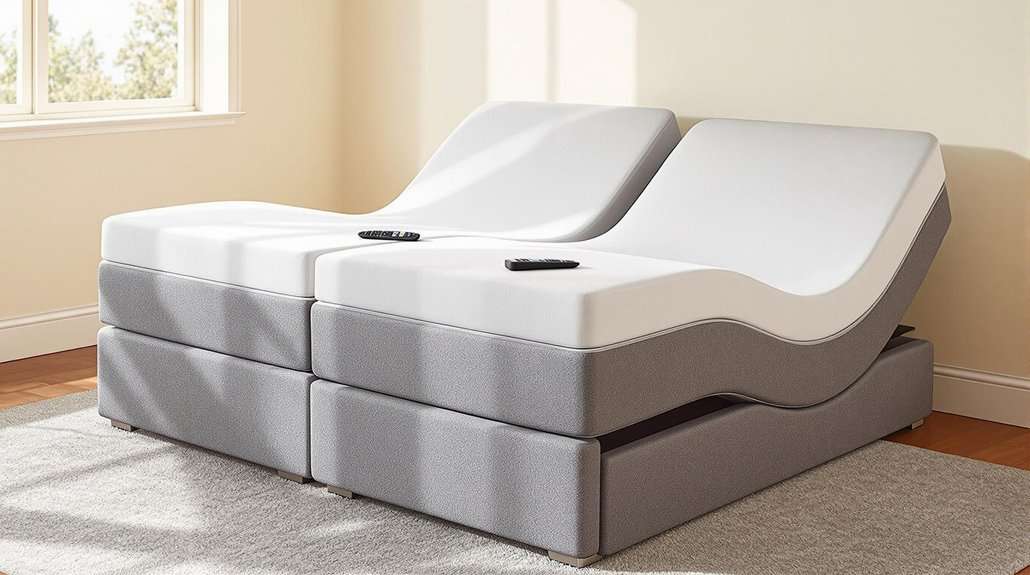
Building upon the established performance metrics of leading models, the selection process for an adjustable bed requires systematic evaluation of specific biomechanical and functional parameters. Primary considerations encompass therapeutic mobility features, biomechanical adjustability, and operational accessibility tailored to geriatric needs. Most quality adjustable beds offer a weight capacity range between 600-1,000 pounds. Quality models typically range in price from $1,000 to $1,500 for a Queen size base.
Critical analysis of features comparison data indicates prioritization of fundamental capabilities: precision body positioning, wireless control interfaces, and mobility assistance mechanisms. User testimonials consistently emphasize the significance of split adjustment functionality for couples and programmable position memory for therapeutic consistency. Operational parameters must include assessment of remote control ergonomics and interface simplicity.
Implementation considerations necessitate evaluation of installation logistics, warranty coverage parameters, and brand compatibility metrics. Strategic assessment should incorporate:
- Height adjustability range for transfer optimization
- Massage functionality gradients
- Zero-gravity positioning capability
- Under-bed illumination systems
- Voice command integration potential
Technical specifications must align with therapeutic objectives while maintaining operational simplicity. Integration of USB connectivity and predetermined position settings enhances functional utility. Warranty duration and trial period parameters require careful evaluation to ascertain long-term viability and user satisfaction within established therapeutic frameworks.
Setup and Maintenance Tips
Proper setup and consistent maintenance protocols form the foundational framework for ideal adjustable bed functionality in geriatric care environments. Following thorough installation guidance guarantees peak performance and longevity of the adjustable bed system, while implementing a structured maintenance checklist facilitates early detection of potential operational issues. Enhanced sleep quality has been consistently reported by elderly users who properly maintain their adjustable beds.
Initial setup requires meticulous attention to electrical connectivity, surface stability, and component compatibility. Expert guidance recommends two person installation for safe and proper bed assembly. Caregivers should verify proper mattress specifications and secure headboard attachment to prevent mechanical interference during articulation sequences.
- Daily operational assessment: Inspect power cord integrity, verify remote functionality, and monitor mattress alignment
- Weekly surface maintenance: Conduct thorough frame cleaning, examine mechanical components, and assess joint mobility
- Monthly systematic evaluation: Perform lubrication protocols, rotate mattress positioning, and test all adjustable features
- Quarterly extensive inspection: Evaluate electrical systems, verify structural integrity, and document wear patterns
Implementing preventative maintenance protocols and addressing mechanical anomalies promptly enhances bed functionality and guarantees resident safety. When operational irregularities occur, systematic troubleshooting procedures should be initiated, beginning with manual consultation and progressing to professional intervention when necessary.
Frequently Asked Questions
Can Medicare or Insurance Help Cover the Cost of an Adjustable Bed?
Medicare coverage is available for adjustable beds when prescribed as medically necessary DME under Part B. Various insurance options may provide partial coverage, subject to policy specifications and documented medical necessity requirements.
How Long Does It Typically Take to Get Used to Sleeping Elevated?
Like climbing a gentle mountain, adapting to elevated sleep typically takes 1-3 weeks. During this adjustment period, most individuals gradually experience improved sleep quality and health benefits as their body acclimates to the position.
What Happens to the Adjustable Bed During Power Outages?
During power interruptions, adjustable beds typically return to a flat position with integrated safety mechanisms. Many models feature power backup systems or manual operation capabilities to maintain functional positioning and guarantee user accessibility during outages.
Can Two People With Different Preferences Share a Split Adjustable Base?
Yes, split adjustable bases enable partners to independently customize their sleep positions and comfort levels. Each side operates autonomously, allowing simultaneous yet distinct adjustments for ideal biomechanical support and personalized ergonomic preferences.
Do Adjustable Beds Make More Noise as They Get Older?
Mechanical wear can increase operational noise over time. Regular bed maintenance tips including lubrication and component inspection, combined with proper noise reduction techniques like tightening connections, can effectively minimize sound production during articulation.
CONCLUSION:
Selecting an ideal adjustable bed requires careful evaluation of biomechanical support features, articulation mechanisms, and safety parameters specifically engineered for geriatric needs. The integration of advanced positioning technology with therapeutic functionalities demonstrates significant potential for enhancing elderly mobility and independence. Critical assessment of weight capacity, fall prevention features, and ergonomic controls ultimately determines long-term efficacy. Investment in a medically appropriate adjustable bed system represents a fundamental component of thorough geriatric care infrastructure.

